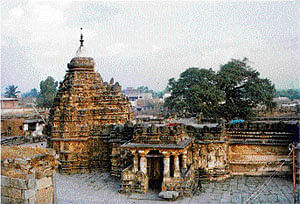
Where people belonging to the Muslim community participate in a homa (a ritual) conducted by the Hindus at a temple; where people of both communities celebrate their festivals together.
Among other interesting aspects of the town is an unusual Shaiva temple, with its linga outside the sanctum sanctorum.
Also, the town is said to have been home to a Muslim saint, Shishunala Shareef Saheb, who migrated to India from Baghdad.
The town is home to grand Jain basadis, that tell us that Jainism had flourished in this part of the State. Lakshmeshwar was ruled by the Chalukyas, the Rashtrakutas, the Vijayanagar rulers, the Adil Shahis and the Marathas. During the British period, it was under a Miraj Maratha Patvardhan.
Known as Puligere earlier
History records that in the past, it was known as Puligere or Puligere Munnuru. It was the headquarters of 300 villages. During the 12th century AD, a local chieftain, Lakshmerasa had constructed a Shaiva temple dedicated to Lakshmaneshwara. Later, the town came to be known as Lakshmeshwar. It was a great educational centre.
A locality in the town called Brahmageri was home to great saints, poets and scholars. Pampa, a renowned poet lived here. It is said that his mother belonged to nearby Annigeri, another Jain centre.
At one point in time, the town was known for its earthenware and handloom. In the changed circumstances, as there was no demand, potters and weavers were compelled to look for other sources of livelihood.
Although there are several attractive monuments, Lakshmeshwar is mainly known for the tomb of Hazrat Sayyed Suleman Badshah Qadri. He was a contemporary of Shishunal Shareef Saheb, the Kabir of Karnataka.
Abdul Kareem, former Chairman, State Minorities Commission who hails from Lakshmeshwar, points out that the sufi had migrated to India from Baghdad. After visiting several places in the North preaching universal brotherhood, he came to Hubli and taught at a madrasa.
Legend has it that, at that point, a prominent citizen of Lakshmeshwar, Razzak Baig Mirza, lived in misery. He requested the saint to pray for his prosperity. His prayers were answered, and soon after that, his life changed for the better.
He persuaded the saint to settle at Lakshmeshwar. The saint finally heeded the request of his disciple. Kareem points out that even today, the descendents of Razzak Baig Mirza can be seen in Lakshmeshwar.
It is said that this man of God lived only on milk and devotees presented him with pots of milk. Hence, he earned the endearments of Doodh Peeran and Doodh Nana. His urs is held during Shawwal month of the Islamic calendar.
The Someshwara temple is an important sacred structure here. Built in the 11th century AD, it represents the ornate Chalukyan style of architecture with friezes of elephants and richly carved elaborate motifs. There are 16 bell-shaped decorated pillars.
The temple has the idols of Shiva and Parvati riding a nandi (the bull) in the sanctum sanctorum. It is interesting to note that it is the only temple in Karnataka with such a rare idol of Shiva and Parvati on the nandi.
Unlike in other Shaiva temples, the linga is outside the sanctum sanctorum. The engineering skills of the builders of that time is evident, as on the day of Ugadi, (the new year), the sun’s rays fall directly on the deities. There are 53 inscriptions kept in the premises of the temple which date back to the early seventh century AD to the 16th century AD. A legend has it that Adayya, a devout Shaivite had come to Lakshmeshwar from Kashmir.
He had married a Jain woman called Padmavati. As a devotee of Shiva, he had vowed to bring to Lakshmeshwar an idol similar to the one in the famous temple of Somanath in Gujarat.
Adayya undertook the arduous journey and returned after 22 days. He got a replica of the idols from the Somanath temple. made, and to fulfill his vow, he installed the deities at the Someshwara temple.
The Shankha basadi built in the seventh century A D is the oldest Jain shrine here. It is said that Pampa wrote his famed works in this basadi. Apart from the Ananthnath basadi, the Mukti Mandir, there are several temples dedicated to Lakshmaneshwar, Hanuman, Basavanna, Baleshwar, Amba Bhavani and others.
Ankush Khan, the governor under Ibrahim Adil Shah II, constructed the beautiful Jamia Masjid in 1617 A D. The main entrance has two tall, graceful minarets. It is also popularly called the Kali Masjid.
The other mosques as well as the tomb of Malik Sadat represent grand, ornate Adil Shahi architecture. Ankush Khan, a saintly person, was buried on the outskirts of the town at Manjalapur. He had constructed a mud fort which is in ruins now.